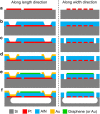Graphene-aluminum nitride NEMS resonant infrared detector
- PMID: 31057826
- PMCID: PMC6444720
- DOI: 10.1038/micronano.2016.26
Graphene-aluminum nitride NEMS resonant infrared detector
Abstract
The use of micro-/nanoelectromechanical resonators for the room temperature detection of electromagnetic radiation at infrared frequencies has recently been investigated, showing thermal detection capabilities that could potentially outperform conventional microbolometers. The scaling of the device thickness in the nanometer range and the achievement of high infrared absorption in such a subwavelength thickness, without sacrificing the electromechanical performance, are the two key challenges for the implementation of fast, high-resolution micro-/nanoelectromechanical resonant infrared detectors. In this paper, we show that by using a virtually massless, high-electrical-conductivity, and transparent graphene electrode, floating at the van der Waals separation of a few angstroms from a piezoelectric aluminum nitride nanoplate, it is possible to implement ultrathin (460 nm) piezoelectric nanomechanical resonant structures with improved electromechanical performance (>50% improved frequency×quality factor) and infrared detection capabilities (>100× improved infrared absorptance) compared with metal-electrode counterparts, despite their reduced volumes. The intrinsic infrared absorption capabilities of a submicron thin graphene-aluminum nitride plate backed with a metal electrode are investigated for the first time and exploited for the first experimental demonstration of a piezoelectric nanoelectromechanical resonant thermal detector with enhanced infrared absorptance in a reduced volume. Moreover, the combination of electromagnetic and piezoelectric resonances provided by the same graphene-aluminum nitride-metal stack allows the proposed device to selectively detect short-wavelength infrared radiation (by tailoring the thickness of aluminum nitride) with unprecedented electromechanical performance and thermal capabilities. These attributes potentially lead to the development of uncooled infrared detectors suitable for the implementation of high performance, miniaturized and power-efficient multispectral infrared imaging systems.
Keywords: MEMS; NEMS; aluminum nitride; graphene; infrared detector; piezoelectric; resonant sensor.
Conflict of interest statement
The authors declare no conflict of interest.
Figures








References
-
- Masmanidis SC, Karabalin RB, De Vlaminck I et al. Multifunctional nanomechanical systems via tunably coupled piezoelectric actuation. Science 2007; 317: 780–783. - PubMed
-
- Li M, Tang HX, Roukes ML. Ultra-sensitive NEMS-based cantilevers for sensing, scanned probe and very high-frequency applications. Nature Nanotechnology 2007; 2: 114–120. - PubMed
-
- Wojciechowski K, Olsson R, Tuck M et al. Single-chip precision oscillators based on multi-frequency, high-Q aluminum nitride MEMS resonators. 2009 International Solid-State Sensors, Actuators and Microsystems Conference (TRANSDUCERS 2009); 21–25 Jun 2009; Denver, CO, USA; 2009: 2126–2130.
-
- Zuniga C, Rinaldi M, Piazza G. Reduced viscous damping in high frequency piezoelectric resonant nanochannels for sensing in fluids. IEEE 24th International Conference on Micro Electro Mechanical Systems (MEMS 2011); 23–27 Jan 2011; Cancun, Mexico; 2011: 960–963.
-
- Rinaldi M, Zuniga C, Piazza G. Ss-DNA functionalized array of AlN contour-mode NEMS resonant sensors with single CMOS multiplexed oscillator for sub-ppb detection of volatile organic chemicals. IEEE 24th International Conference on Micro Electro Mechanical Systems (MEMS 2011); 23–27 Jan 2011; Cancun, Mexico; 2011: 976–979.
LinkOut - more resources
Full Text Sources
Molecular Biology Databases
